Jamaican Dogwood (Piscidia piscipula) Monograph

Introduction
In late January 2014 I went down to South Florida to identify and gather some Jamaican Dogwood (Piscidia piscipula, Fabaceae). This is my second time making this trip. I had also gone down in 2007 and wrote a blog about it here. Back then I gathered enough to make 4 full gallons, and have used nearly all of it over the past 7 years, so it was time to gather some more.
While I like to gather my own plants for medicine anyway, I had extra incentive with Piscidia. Time for a quick story. As its common name indicates, it grows in Jamaica and I have a number of friends who go to Jamaica regularly. I asked a few of them if they could bring me back a specimen of the bark so I could see what it looks like. Two friends, who know local Jamaican bush doctors, did so. The bark samples they brought back were different from each other, clearly coming from different plants. This made me cautious about what might end up in the marketplace as Jamaican dogwood medicine. Along with that, I have my own inclination to see the plants I use for medicine growing in their ecosystems. So the next time I was invited to teach in south Florida, I left some time in my plans to try and find it. You can see this earlier story on my previous blog post.
This monograph will discuss more about Piscidia’s medicinal properties and clinical uses. I also cover some relevant botany for any intrepid wildcrafters who may want to gather (but not over-harvest) it themselves.
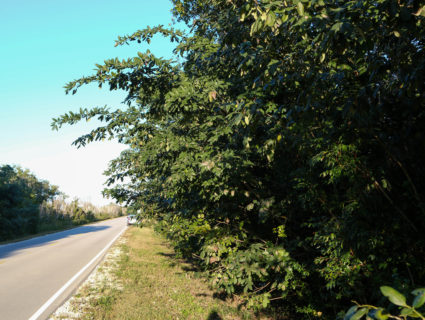
Botany
Jamaican dogwood grows in Jamaica, Haiti, S. Florida and south into Central America (map; http://eol.org/pages/415760/maps). It is in the Pea family (Fabaceae or Leguminosae) and not in the Dogwood family (Cornaceae). It is not the most distinctive tree at first glance but there are a few characteristic features that make it reasonably easy to identify. I have not seen it in flower or fruit, so all of my identification is from other plant parts. The following botanical descriptions are from personal observation, which may differ from some field guides.
On a slightly different note, I find it interesting that Piscidia is the only plant I know in the Fabaceae that is used for pain. It is a very large family with some well-known medicinal members such as Astragalus, Licorice (Glycyrrhiza spp.), and Senna (Cassia spp.) and the constituents in Jamaican dogwood are unique in the family.
Size-while those grown in the open can get fairly big, they are generally mid-sized and tucked into the understory with trees of similar size. The larger trees can reach the same height as a mid-size Oak, but generally they are about the size of Apple trees (though not the same form).
Flowers and Fruit-I have not yet seen the flowers or fruits except in photos. The flowers are the typical butterfly-shaped pea flowers. The fruits are a bit more unusual looking. You can easily find photos of both online.
Leaf-the leaves are pinnately compound and composed of approximately 7-9 leaflets. The leaf itself is fairly long, about a foot when fully grown. One of the most obvious features of the plant is the distinctive leaflet color. The topside is a darkish green while underneath it is grayish-green due to its hairiness. This contrast is one of the first things to look for when trying to identify Piscidia.

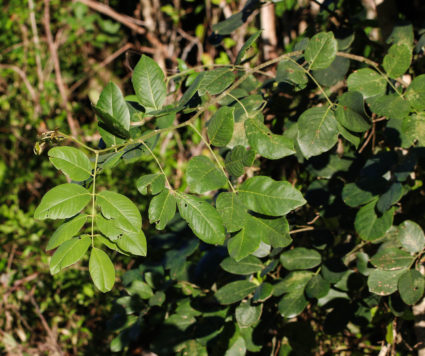
Bark-depending on its age, the color of the bark varies considerably. Young twigs are a grayish green while medium-size branches are a darker green. A distinctive feature is the white lenticels in both of these branches (you cannot see them in older branches). Lenticels are pores where gas exchange takes place in the woody parts of trees and shrubs and are visually apparent and a helpful feature for identifying Piscidia. While other plants have obvious lenticels, the elongated shape and white against green bark is characteristic.As the branches age they often have patches of lichens growing on them. And the main trunk is sort of gray with green undertones.
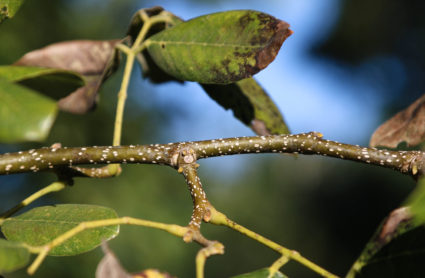
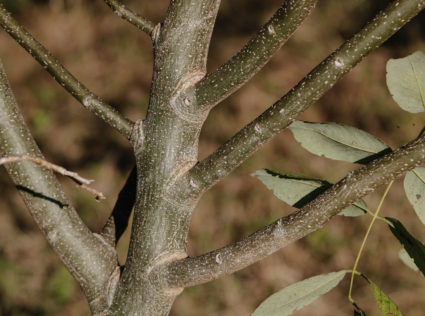
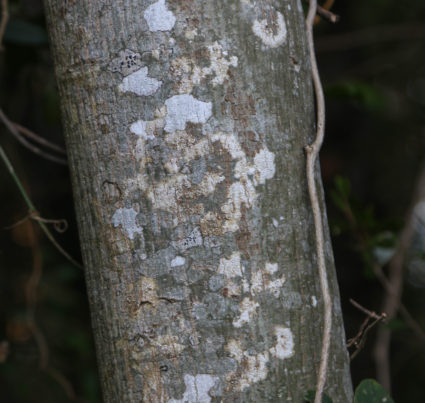
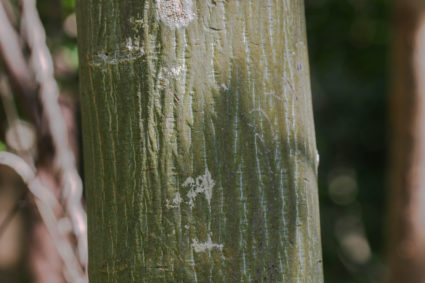
Young growth-the most notable identifying feature for Piscidia in winter is the young growth on the ends of some branches. Personally, I admire this growth. Part of my fascination is that it was how I first made positive identification when I initially sought out Piscidia. And as a photographer I find it lovely in its own right (which will be obvious from all my photos).
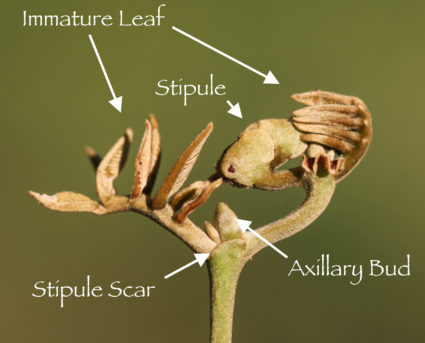
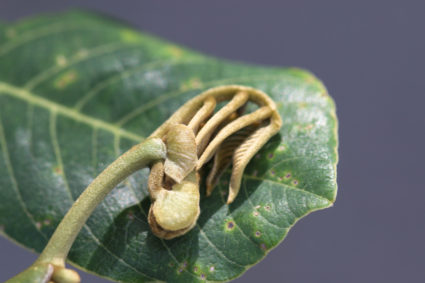
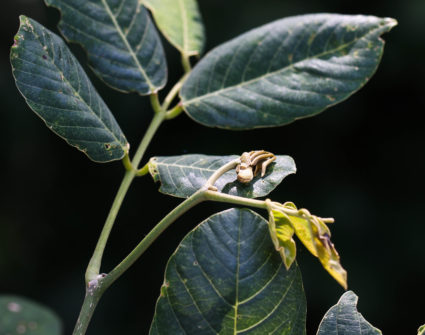

The young growth is made up of small, unfurled hairy leaves surrounded by stipules, which are the parts that protect the young leaves until they emerge. The ends of the twigs are usually forked, with an axillary bud in the middle and leaves (initially wrapped in stipules) on either side. Look at these photos for a visual cue. As I said, I find this group of structures the most important trait to identifying a Piscidia when there are no flowers or fruits.
Equipment for Wildcrafting and Medicine Making
- Saw-a pruning or other type to cut branches
- Debarking knife or other tool to peel bark
- Cloth-or something to peel the bark onto
- Vitamix or powerful blender (optional)
- Ethanol-for tincture making
- Jars
- Scale and measuring cup
- Label making supplies

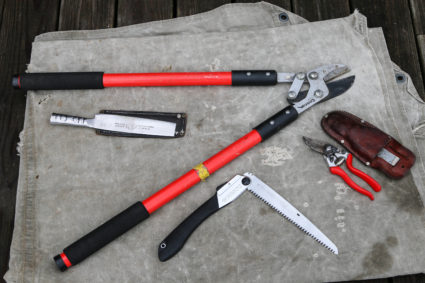
Wildcrafting
This section is a bit difficult to write since I worry about this plant being over-harvested. But since I am writing about my Piscidia wildcrafting adventure, it seems obvious and prudent to let folks know best practices for gathering this useful medicinal plant.
The first and most important part about gathering Piscidia is to make sure it is plentiful and growing well where you are gathering it. It is not on any endangered plant lists, but it grows in only a small region in the continental US. And as I am talking about how useful it is I feel an obligation to say that I spent a lot of time looking for places where this plant was ethically harvestable. Please do the same.
One of the observable characteristics about Piscidia is that it likes to grow in full sun. Most often it is found growing in mixed woodlands on the border between the woods and an open space such as a roadway or power line clearing. You can see its branches reaching through the other trees and gathering sunlight at the edge of the woods. This makes it easier to spot while driving along back roads, especially once you learn the distinctive green leaf color.
It is the bark that is used as medicine, so the branches are gathered. On some of the plants you can see where the branches are continually cut back to keep the right-of-way clear. I think this is a good place to gather them as they will likely get cut off anyway. As with any time you are cutting off tree branches, employ good pruning techniques. Cut smaller branches where they meet a larger branch or the trunk. Do not cut in the middle of a branch as this makes it easier for disease to enter the tree. So cut the branch as close to the next branch as you can, a good pruning saw works well here. You may also have to cut the branches into smaller pieces for you car.

Preparing the Bark
There are a few supplies that are handy to have on hand to process the branches and stems. These include a tarp to peel the bark onto, a saw to cut the pieces into manageable sizes and a good debarking knife. My favorite is a lightweight cleaver. If you are peeling a lot of bark, it is important to have a comfortable knife to do this, as this motion can be hard on the wrist and often creates blisters. Using a small pocketknife makes for difficult debarking. Even with a good knife, I started wearing a glove to protect my hand, though I did have a lot of bark to peel. Once you have peeled all of the bark, make sure that there is a lot of space between the peeled bark so that air can circulate between them they don’t mold (which would be quite annoying after all that hard work, yes?). Also, move them around daily to help facilitate their drying.
After the bark was reasonably dried I had to send it to myself as I was traveling by plane (and thank you again for sending it Susan Marynowski). This was expensive ($110), and a bit anxious-making, as I hoped the drying bark wouldn’t mold on its way to NY. And shew, it didn’t.

Medicine Preparation
I finished drying the bark by keeping it on a tarp near a window. When it was time to tincture it, I went to look on former labels to see the ratios and percentages I used last time I prepared it. It was 1:4 50% ethanol. I wanted to use the same numbers again as that medicine worked well and I am a bit conservative that way (if it worked last time…).
It is not easy to tincture strips of bark. They bend when you try to cut them with pruners and are very difficult to slice with a cleaver. So, I stomped on them. Yup, I had them in a large tarp which I folded over, and I walked all over them for days scrunching them down ever more. When it was time to tincture them, I wanted to use the blender to reduce it further because another problem with bark is that they take up a lot of room in a jar. We could only stuff 13 oz of the bark into a gallon jar. This means if we were going to go with 1:4 ratio, there would only be 52 oz of ethanol. And it being a gallon jar (128 oz) it would only cover about 2/3’s of the bark, leaving a lot of plant above the alcohol line. So reducing it with the blender was a better way to have all of the bark covered and saturated with ethanol. However, even with a Vitamix blender, strips of bark are problematic, as they still don’t break down easily. So we experimented for a while and finally figured out that adding more alcohol while feeding small amounts of bark into the blender while it was churning worked best. Also, the reverse switch on the Vitamix blender is helpful. This was time consuming, but after many hours all of the bark was processed. When we finally press it out, I think there be about 5 gallons of tincture, which should last me a few years. And then, back to Florida I go.
I have not used Piscidia in any other way besides as a tincture, so I do not personally know it effects in different medicinal preparations.
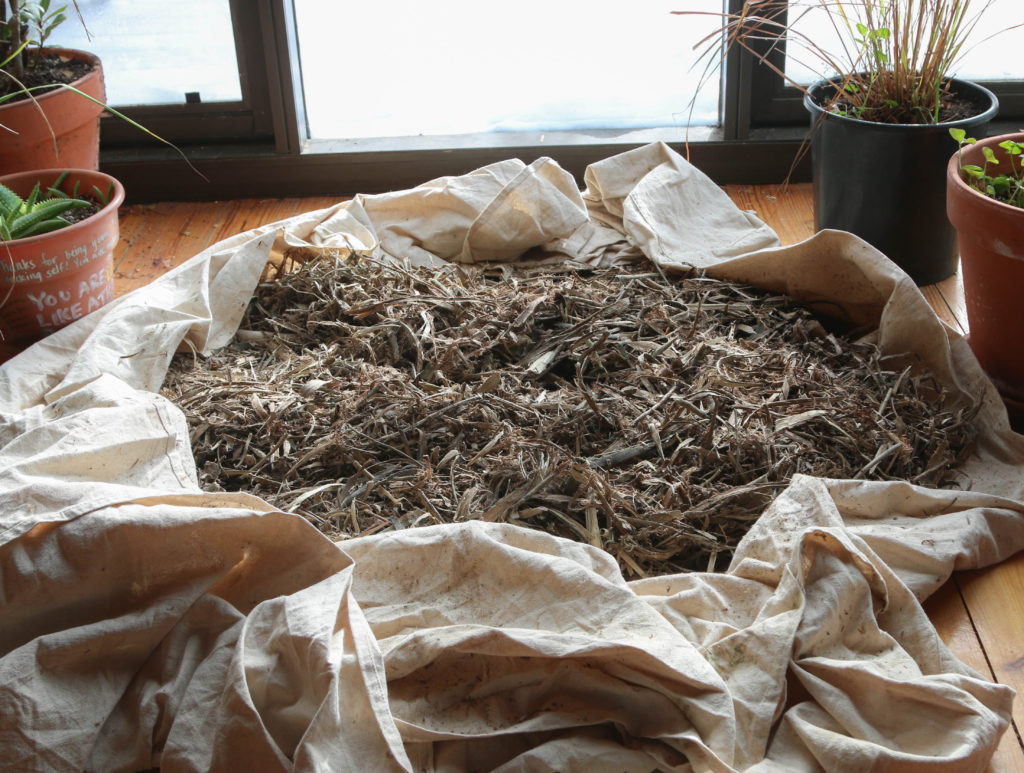
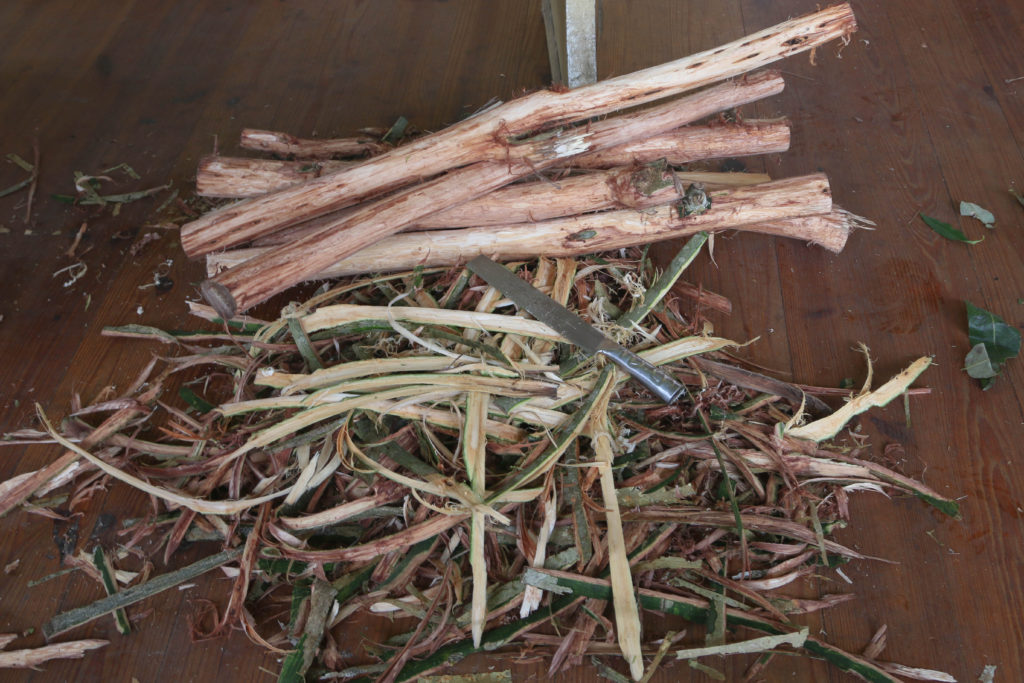
Piscidia as Medicine
Introduction
As I write about Piscidia as a medicine, it is important to know that much of my description is based on using it over the past 7 years. The reason I say this is that while there is validity to clinical observations it also increases the risk of bias. Hopefully this monograph encourages others to experiment with this plant and figure out best medicinal uses.
As I mentioned above, I did not use this plant for a long time, due to being unsure of medicines labeled Jamaican dogwood. Initially I wasn’t sure how to best prepare it or how best to use it. I had read enough to know that its basic medicinal action was for pain, but that is a broad description. So, I experimented with preparation methods and figuring out the specifics of its medicinal activity. After about 7 years and a number of gallons later, I feel I have a reasonable idea on how to use this plant as medicine. Though this should not inhibit anyone from continuing to pursue other uses and preparations.
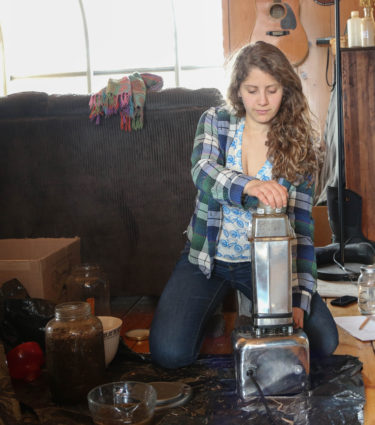
Medicinal Uses
I have become an admirer of Piscidia as a medicinal plant, one I am glad to get to know and apply clinically. I have only used it in tincture form, so all discussion of it here is about it in tincture form. Piscidia is a very serviceable pain medicine, especially for general body pains (such as after an accident or a jousting tournament) and as an adjunct for skeletal muscle pain. Its sedative effects are minimal which makes it useful for daily use as it does not impair the cognitive process. It is an excellent first aid remedy because when it works (no one plant works all the time) it works reasonably swiftly and can take the edge off of acute pain. In other words it is useful plant for a wide variety of pain. It combines well with other plants (see Combinations below). Some plants are stronger pain relievers such as Valerian (Valeriana officinalis), or Hops (Humulus lupulus), but they may leave the patient feeling lethargic and not thinking clearly, while Piscidia does not have this effect commonly. That can also be a disadvantage as some times, such as after a traumatic accident, it is helpful to the mental edge off, but then it can be combined with them.
Another important attribute about Piscidia is that it is well tolerated with unwanted side effects being uncommon. This gives more room to play around with dosages when using it for treating pain.
For me, it is a classic first aid plant. It can be offered to someone soon after they arrive to a first aid station, even while still evaluating the extent of an injury and the dosage can be incrementally increased.

Dosages
When administering Piscidia and other pain medicines, it is helpful to evaluate an individual’s reaction to the specific plant before giving larger amounts. Herbal medicines that influence the nervous system often affect people with a variable range of individual reactions to the specific plants. This spans from having very little reaction to feeling disoriented or tired. While evaluating dosage by body size is helpful, this individual responses seem even more important to take into consideration. Initially try smaller amounts before giving large doses, especially in sensitive individuals (and they often know who they are).
I rarely see unwanted side effects from Piscidia, which makes it reasonably safe to use and larger doses can often be given. I have mainly used it with teens to older adults, but it seems like it would be safe for children. It is one of those medicines that you can start with a small to medium-sized dosage and just continually increase until the effect you are looking for is achieved or nothing is further gained from giving more.
For most uses, start with approximately ½ dropper (.6 ml) to two droppers (2.5 ml.), and then continue giving more in these increments. If there are other herbs in the formula, you may have to adjust your dosage depending on their strength.
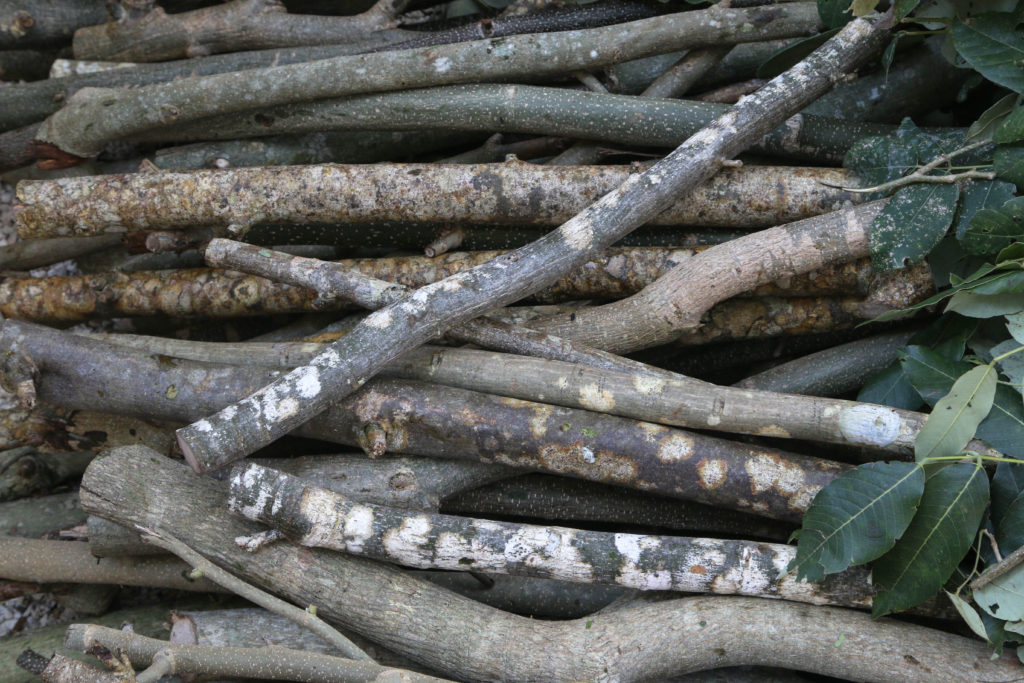
Formulation and Combinations
Depending on what you are using it for, Piscidia combines well with other medicinal plants. It has an ‘adjunct’ quality, meaning it seems to increase the medicinal effects of other plants as well as having its own amplified when they are used together. Two specific plants I think it works particularly well with for pain are Skullcap (Scutellaria lateriflora) and Hops (Humulus lupulus). The following are some helpful combinations.
- For skeletal muscle pain; Skullcap, Pedicularis (Pedicularis spp.), Black cohosh (Actaea racemosa) and Willow (Salix spp.)
- For insomnia due to body aches; Skullcap, Valerian (Valeriana officinalis), Wild lettuce (Lactuca spp.) and Hops.
- For a recent injury; Valerian, Kava kava (Piper methysticum) and Wild lettuce.
Piscidia does not have obvious antiinflammatory effects, but since inflammation is a common factor in pain, it can be combined with antiinflammatories such as Willow, Licorice (Glycyrrhiza spp), Arnica (Arnica spp.), Meadowsweet (Filipendula ulmaria) and Yarrow (Achillea millefolium) to help reduce the sensation of pain while the above herbs decrease inflammation.
Conclusion
I guess it will be obvious from this monograph that I have a fondness for Jamaican dogwood. It started with my finding, gathering, processing and making medicine from this plant, to incorporating it into clinical herbal practice. It is one of the plants that has obvious medicinal benefits, which I find very satisfying. So even if you don’t gather your own Piscidia, I hope you can find a good source and begin to use this helpful medicinal plant.

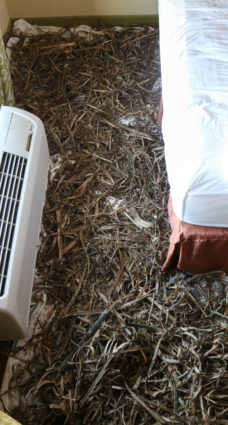

This description of Jamaican Dogwood was incredibly helpful! Thanks for putting so much thought and research into this post ~ my partner suffers from pain due to chronic use of his body for construction work. He read about J.D. helping and since it doesn’t grow here and I hadn’t had prior exposure to the plant I researched a bit and fortunately your post has helped quite enlighten me to its usage/dosage. Hhhmmm, now if only I can get it to grow in SE Alaska 🙂
I am taking 21 drops of it before sleeping and it is helping with my insomnia
Thank you for writing twice, about your experience with Piscidia piscipula. This helps strengthen my growinging knowledge of this plant in its use in my own walk and bringing it’s presence into family and friends’ lives. Thank you.
I have been giving full body steams of jamaican dogwood, lobelia, and lavender to clients with pain. It smells a bit like chocolate, and the effects are both immediate and long lasting. Thank you for this well written and photographed piece, once again!
That is very interesting Kristi, thank you for the information and I am glad you enjoyed the article.
Thank you for sharing your materia medica! The information is percise, clear and I especially appreciate your personal experiance.
Namaste’
Earth Fairy
Thank you Kalin
Hi, this is more of a question, if you are still answering from this article.
I live in Key Largo, Florida and have used this plant as well to make medicine. I use it specifically for back pains. I was told to use the Root bark of this plant. So I tried an experiment and made a tincture of both the root bark and branch bark. I noticed the root bark was very sappy and sticky and made a blood red tincture. The branch bark not so much and the tincture was green. I have tried both medicines and the root bark seems much more effective. Do you have any info on this?
Thanks! Love your work!
Vicki
Hello Vicki
I am glad that you make and experiment with your own medicines. I have not used the roots of this tree so I don’t know if one is better than the other. But there is a chance there could be a difference as I use the root barks of some plants (i.e. Viburnum prunifolium) rather than the branch bark.
Do you sale your tinture
Hello Felicia
I am sorry, but I do not sell the tincture.
~7Song
Hello and thank you for such an informative blog here. I have just started using Jamacan dogwood for severe nerve pain in both legs. I understand dosing can vary as tolerated and I know I tolerate one dropper full well. The effects don’t last as long but are extremely helpful. How long should one dose last and how frequently would it be safe for me to use? I’m about 135lbs and I suffer from extreme constant chronic pain from nerve impimgment in now both legs which is unbearable even on strong meds. Id like to limit meds and use natural means if possible but this is the only thing ive found to work similar to pain meds. It just doesn’t last nearly as long which is why I’m contacting you. I’ve also read many articles sayin it can be toxic but I’ve also read you use right much yourself. Open to any and all recommendations. I appreciate your heartfelt work with herbalism and your time to read this. With thsnks, Renae